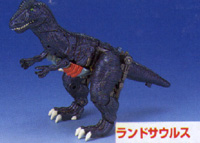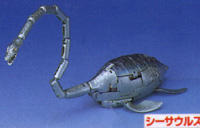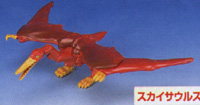 BEAST
WARS: TOY REVIEW
BEAST
WARS: TOY REVIEW
Gimmicks: Firstly, there's a cavity inside the
tail where you can store the Magmablade weapon. I recommend that you don't
push it in too far, otherwise it becomes somewhat difficult to take out
afterwards. Secondly, open up the jaw and behold a spring loaded missile
launcher. Insert a missile (either a Giga missile or one of Skysaurus'
Wing missiles)... opening the mouth fully launches the missiles (similar
to how Scorponok's launcher works). Yay.

Gimmick: Squeeze the hind flippers together and
the fore flippers lunge out. Do this repeatedly to create a swimming action.

Gimmick: Pull on the tail and the wings span out
to a whopping 26 centimetres!
Phase One: Seasaurus
Although the instructions say to lift up the tail section,
I recommend holding the shoulders and pulling it back and then disconnecting
the tail section. It's a lot easier and the dinosaur would've split into
half if you went by the book anyway. Pull the shoulder and tail sections
all the way back. Pull out the gestalt legs. Swing them towards the back
at 90 degrees. Open up the two panels behind the beast shoulders. Turn
the lower legs, lift up feet and open the toes.
Phase Two: Merging Seasaurus and Landsaurus
Attach the top half of Seasaurus onto the underside of
Landsaurus' tail (there's a clip and peg). Attach the Seasaurus' underbelly
onto the upperside of Landsaurus' tail (again with a clip and peg). Hmm...
now it looks like two dinosaurs doing something quite unmentionable. Ookay...
let's move on...
Phase Three: Attaching Skysaurus
Swing down the entire torso/head and swing the legs up.
Attach Skysaurus via the two slits on Seasaurus' underbelly with the beak
facing backwards.
So what have we here? A beast with features of three different
animals combined into one... fused... n-n-n-n-NOOOOOO!!! It's a
Fuzor!!! Aarrggghhhh!!!
Okay... settle down... haaaahhh.... Grr!! It still looks
really silly!! Ah well... it's one heck of a gimmick (and it actually looks
better than most Fuzors too).

Phase One: Landsaurus
Pull the breast section forward. Open up the underneck
panels and remove the launcher. Turn the neck-head section to Landsaurus'
right at 90 degrees. Fold the neck out at 90 degrees. Turn the breast section
180 degrees. Lift out the clogs (those are the dark grey robot bits behind
the legs) and swing them down so it locks onto the lower legs. Lift up
the hooks so they're inbetween the beast toes. Swing out robot heels. From
the cavities in the upper legs, swing down leg covers. Unlock the stomach
and lift up the tail. If you took my advice earlier, the Magmablade should
fall out, otherwise, have fun picking it out and don't say I didn't warn
you. Close the lid (the beast stomach) to cover the gaping hole in the
tail. Turn the tail back 180 degrees and lock the peg into the hole on
the back. Swing up the rump section, bring the legs down and join the hip
section (like Fuzor Silverbolt and Galvatron). Clip the rump panel onto
the hip section. Open up the two side panels directly above the hips.
Phase Two: Skysaurus
Lift up tail. Swing up the neck section. Now here's the
fiddly part... attach Skysaurus onto Landsaurus by inserting the lower
peg onto a hole behind the breast panel. Slot Skysaurus' neck into a slot
in the breast panel and bring Skysaurus' legs over and clip the feet onto
the upper pectoral region. Fold Skysaurus' head down into the groove in
the robot chest. Swing Landsaurus' arms back.
Phase Three: Seasaurus
If you haven't already done so, fold the neck and tail
sections back. Open out the robot arms and position them so the palms are
facing inward. Clip the right arm onto the right side of the robot torso
(in the space where Landsaurus' neck once was). Clip the upper half of
Seasaurus onto the back of Skysaurus. This will naturally bring the left
arm into place. This can be a bit tricky at first because Skysaurus sits
so loosely on Landsaurus. Take Seasaurus' head and attach the peg onto
a hole on the left shoulder. Gyaarrrghh!! It's Raksha and her serpent!!!
(:
The other half of Seasaurus clips onto the left forearm,
forming a shield.
Insert the Magmablade into Landsaurus' missile launcher
to form Magmatron's weapon. Insert in between the thumb and fingers on
the right hand. Don't bother with the peg and hole thing.
Gimmicks: The missile launcher can launch the Magmablade. Squeeze the hind flippers on the shield and Seasaurus' swimming gimmick now becomes a pincer weapon. Whatever.
SPARK CRYSTAL LOCATIONS In robot mode, all three sparks are visible. Landsaurus' crystal is located on the missile launcher. Seasaurus' spark is on the left upper arm. Skysaurus' spark is on the underside of the left wing.
In the West, Magmatron was released as part of Hasbro's Beast Machines Dinobot line. The toy was repackaged and the spark crystals were replaced with Dinobot insignias.
Length: 13 metres.
Weight: 2.7 tonnes
Bibliography: Creation
Sensation
Gigantosaurus- 12.8 metres long and weighing 8 tonnes - was the largest land carnivore that ever lived, beating the size of Tyrannosaurus Rex. Gigantosaurus had dagger-like teeth made for cutting flesh. The Gigantosaurus prey were herbivores.During the hunting, they would run in, take a very large bite and then back off and watch until the prey would bleed to death. Gigantosaurus lived during the Cretacious Period (65 million years ago).
Bibliography: The Cretacious Period
Queztacoatlus was a huge pterosaur with a wingspan of up to 15 metres - the largest flying creature of all time. It is the last known pterosaur which survived to the very end of the Cretaceous period. Quetzalcoatlus was named after the Aztec's feathered-serpent god, Quetzalcoatl, by Douglas Lawson who first found the remains at Big Bend National Park in Texas USA. Despite its huge size, the skeleton was lightly built and the whole animal probably weighed no more than 100 kilogrammes. Its neck was extremely long, its slender jaws were toothless and its head was topped by a long, bony crest. Unlike most other pterosaur fossils the Quetzalcoatlus remains have not been found in marine strata but in the sand and silt of a large river's flood plain and this has raised questions about how it lived. It was a good soarer - certainly able to cover large distances. This, coupled with its long neck has prompted the idea that it lived rather like a vulture and fed on the corpses of dead dinosaurs. But some palaeontologists, noting the long slender jaws suggest that it probed soft ground and pools for molluscs and crustaceans. Others think that it flew low over the warm shallow seas plucking fish from the surface
Bibliography: Walking With Dinosaurs